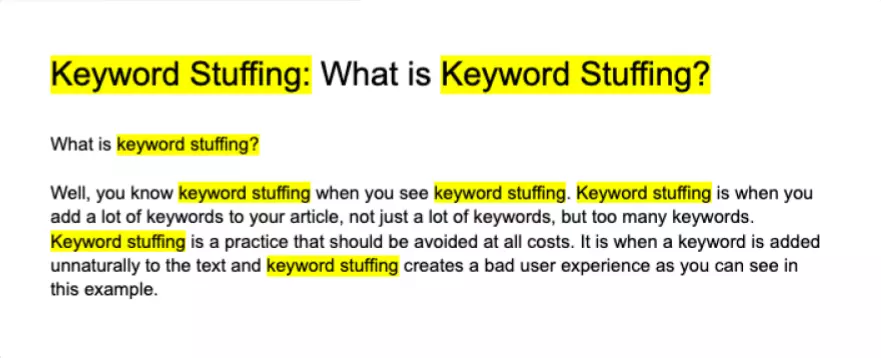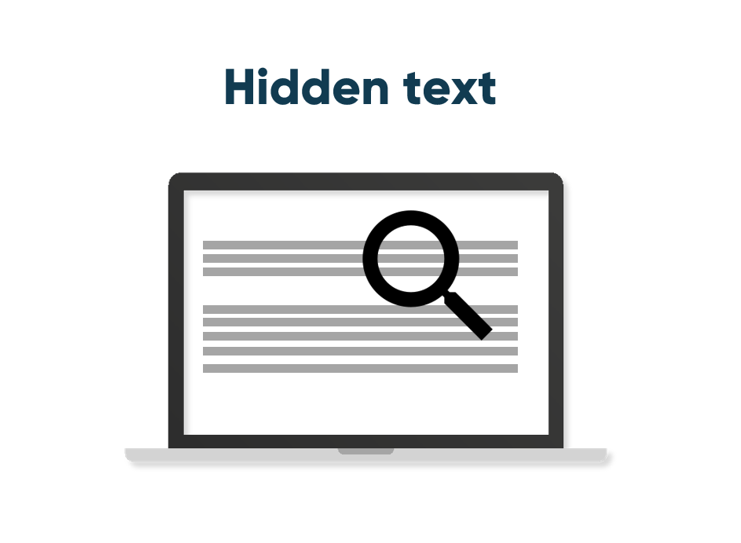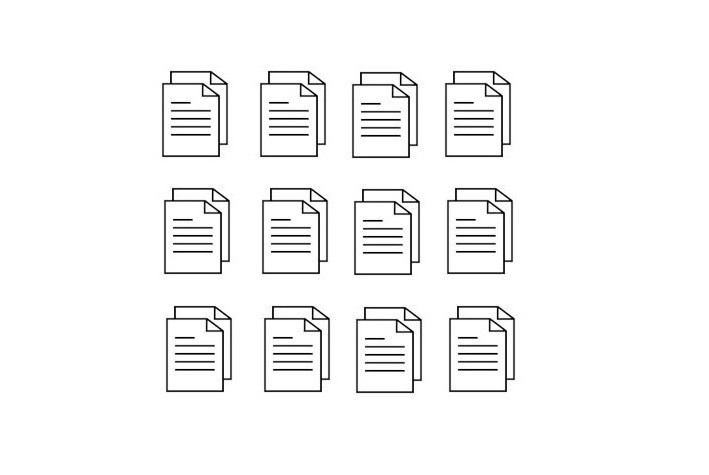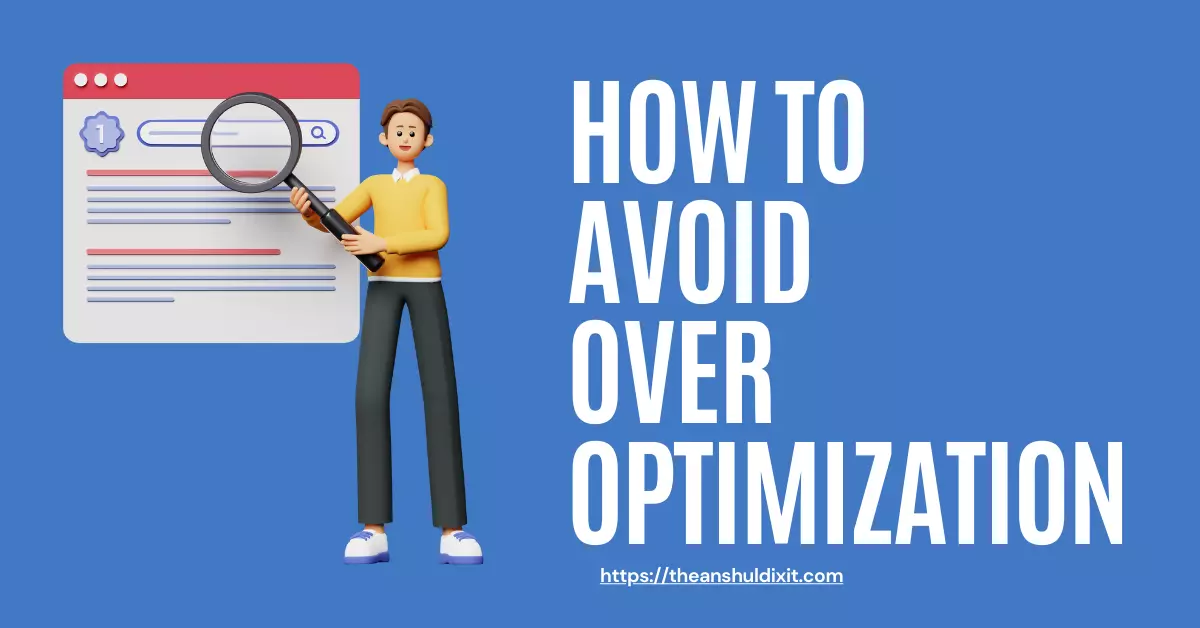Gone were the days when you used to bombard websites with keywords, backlinks, etc. Now, it is called Over Optimization.
If you are still doing it and hoping for better results, you should do one thing. Either, stop hoping or stop over-optimizing your website.
In order to rank higher you need to stay clear of overstuffing. But how do you know if you’re overdoing it?
In this article, I will share a few signs that point to over-optimization. If you are doing any (or all) of these, chances are that you’re excessively optimizing your site to ruin the website’s ability to rank.
First, here’s everything you need to know about the over-optimization.
Table of Contents
What is Over Optimization?
Let’s go back to 1997 when the term “SEO” was coined. In the early days, SEO was largely focused on keyword stuffing, building tons of backlinks, and other techniques that are considered black hat these days to increase a website’s ranking in search results. But, it doesn’t work anymore. With time, search engines became more sophisticated, these techniques became less effective.
Google has rolled out multiple updates like Panda, Penguin, etc targeting sites with low-quality content and spammy backlinks.
On April 24, 2012, Google leveled the over optimization penalty. It completely deindexed sites that were still trying to
manipulate search engine algorithms by using excessive keywords, link-building techniques, or other methods.
Nowadays, search engines like Google, favor sites with
quality content, the number of quality backlinks, and other such factors which I will discuss below.
Why is Over Optimizing Bad?
As far as I can remember there was no concept of over-optimization a decade ago. And, SEO was mainly focused on techniques that are nowadays known as black hat SEO.
However, search engines got more advanced and these techniques became less effective. Hell, Google even targeted those sites and penalized them for using these get-rank-quick schemes.
Most of these methodologies are involved in over-optimizing but search engines are very good at detecting over-optimization, and if they find that you are using too many keywords or keyword-rich phrases, they may penalize your website by lowering its ranking in search results.
Here are some of the reasons why over-optimizing is bad:
- It can make your website look spammy: When you over-optimize your website, you are essentially trying to stuff as many keywords as possible into your content. This can make your website look spammy to search engines, and they may be less likely to rank your website for those keywords.
- It can hurt your user experience: When you over-optimize your website, you are essentially sacrificing the user experience for the sake of search engine rankings. This can lead to users having a negative experience on your website, which can hurt your website’s traffic and conversions.
- It can get you penalized by search engines: As I mentioned earlier, search engines are very good at detecting over-optimization. If they find that you are using too many keywords or keyword-rich phrases, they may penalize your website by lowering its ranking in search results.
Top 6 Signs You’re Over Optimizing Your Blog & How To Avoid
I have come in contact with several websites through my years of experience that were incorporating over optimizing techniques to manipulate SERPs. So, I have curated a list of the most common over optimization signs that you might be doing knowingly or unknowingly.
1. Keyword Stuffing
Keyword Stuffing is one of the most common techniques of over optimization. Keyword stuffing simply means using the same keywords or phrases over and over again in the content in order to increase search engine rankings.

Instead, it harms your website’s organic rankings by making content look spammy and can lead to a penalty from search engines.
Search engines declared it a black hat SEO technique.
If you are doing keyword stuffing, your website may get penalized, which can result in a sudden lower ranking in search results.
Here are some examples of keyword stuffing:
- Using the same keyword or phrase multiple times in a single sentence or paragraph.
- Using the keyword or phrase in unnatural ways, such as repeating it in the same sentence multiple times or using it in a list of keywords.
- Hiding the keyword or phrase in the page’s code so that it is not visible to visitors.
- Using the keyword or phrase in the page’s title tag, meta description, or other metadata excessively.
How to avoid Keyword Stuffing:
There are a number of ways to avoid keyword stuffing. Here are a few tips:
- Use keywords naturally in your content. Don’t try to force them in.
- Vary your keyword usage. Don’t use the same keyword or phrase over and over again.
- Use a keyword research tool to help you find the right keywords to use.
- Focus on creating high-quality content that is informative and engaging.
- Avoid using hidden text or other spammy techniques.
By following these tips, you can avoid keyword stuffing and over optimization at the same time increasing the visibility of your website on search engines naturally.
2. Link Spam
Are you one of those who has devoted their life to acquiring as many links as possible completely ignoring the quality? If yes, then you might face a very hard time my friend.
You need to stop it immediately as it’s a major over optimization sign. Because creating backlinks from low-quality websites, websites that are irrelevant to the content of your website, or websites that are known to be spammy is considered to be spam by search engines.
Therefore, as a consequence of this, you may see a decrease in traffic and even your website may be penalized.
Here are some examples of link spam:
- Buying and selling links.
- Generating links to a website through automated programs.
- Excessive link exchanges and pages are used solely for cross-linking.
- Creating links from low-quality websites or websites that are not relevant to the content of the target website.
- Using hidden text or other spammy techniques to create links.
How to avoid link spam:
Here are a few tips to avoid link spam:
- Only build links from high-quality websites that are relevant to the content of your website.
- Avoid buying or selling links.
- Don’t use automated methods to generate links.
- Don’t create links from low-quality websites or websites that are not relevant to the content of your website.
- Use natural language when creating links.
By following these tips, you can avoid link spam and over optimizing your website.
3. Hidden Text
Hiding texts from users and showing it to only search engine crawlers, is an old technique considered to be spammy by search engines. Because it is often used as a way to manipulate SERPs by forcefully increasing the number of keywords on a page.

However, hidden content can also lead to over-optimization, which can result in penalties from search engines.
When search engines find over-optimization, they may penalize the website by lowering its ranking in search results.
So it becomes very important to identify and eliminate hidden text to search engine visibility.
Here are a few examples of hidden text:
- Using the tag with the style=”display:none” attribute: This will hide the text from human visitors, but it will still be visible to search engine crawlers.
- Using white text on a white background: This will make the text invisible to human visitors, but it will still be visible to search engine crawlers.
Hidden text is considered to be a black hat SEO technique, and it can lead to penalties from search engines. If you are caught using hidden text, your website may be penalized by being demoted in search results or even banned from search engines altogether.
Here are some tips to avoid using hidden text:
- Use keywords naturally in your content. Don’t try to force keywords into your content.
- Vary your keyword usage. Don’t use the same keyword over and over again.
- Don’t use hidden text or other spammy techniques.
- Focus on creating high-quality content that is informative and engaging.
By using the above tips you can avoid using hidden text.
4. Meta Tag Manipulation
Meta tag holds a valuable place in Search Engine Optimization (SEO). As it gives you an opportunity to elaborate upon the important keywords of your website and page.
However, a lot of newbie SEOs try to rank higher by over optimizing meta titles and descriptions using malicious practices like keyword stuffing, hidden text, cloaking, etc.
These are the old practices that are no longer useful, and even risky. If you are caught manipulating meta tags, your website may be penalized by being demoted in search results or even banned from search engines altogether.
Here are a few common Meta Tag Mistakes to avoid:
- Incorrect implementation of meta-tags
- Stuffing
- Repeated keywords
- Using the same Meta tags for every page
- Use only unique tags for your website
- Using Irrelevant Tags
5. Duplicate Content
Creating content that is the same or similar is not a wise strategy. As
Search engines interpret this as a sign of over optimization and will not rank it as highly.

Because, duplicate content can be a problem for search engines, as it can make it difficult for them to figure out which page is the most relevant for a given search query. This can lead to your website ranking lower in search results.
Here are a few things you can do to avoid duplicate content:
- Make sure your content is unique. This means writing your own content or getting permission to use content from other sources.
- Use canonical tags. Canonical tags tell search engines which page is the original version of a piece of content. This can help to prevent search engines from indexing duplicate content.
- Redirect duplicate pages. If you have two pages with the same content, you can redirect one of the pages to the other page. This will tell search engines that the two pages are the same and that they should only index one of them.
- Use a content management system (CMS) that can help you to track and manage duplicate content.
- Use a keyword research tool to help you find the right keywords to use.
- Vary your keyword usage throughout your website. Don’t just use the same keywords in your meta tags. Use them throughout your website, such as in your title tags, headers, and body content.
By following these tips, you can avoid duplicate content and improve your website’s ranking in search results.
6. Pointing All Links to Top-Level Navigation Pages
A sign of a strong and healthy link portfolio is links pointing to deep internal pages and the home page. However, most of the time it happens to be otherwise and that’s when over optimization takes place.
Creating tons of links to the homepage or to main navigation pages like “Contact Us,” “About Us” “Categories” or “Our Services” weakens the link profile. The healthy link profile has links pointing to deep internal pages. A good ratio is 1:1, or 50% of the links pointing to deep internal links.
You should create links but you should not point all the links to top-level navigation pages.
Summing Up
SEO is good and a must thing for a website. But when you get into get-rank-quick schemes that’s when things do downhill. SEO is a long-term game, and you need a strong strategy and execution for SEO effectiveness.
The easiest way to avoid over optimization and improve your website’s ranking in search results is by creating relevant, engaging, and high-quality content that is informative and engaging.
Consistently publishing new content, optimizing your content over time, and avoiding over optimization with keywords will improve your website’s ranking in search results.

